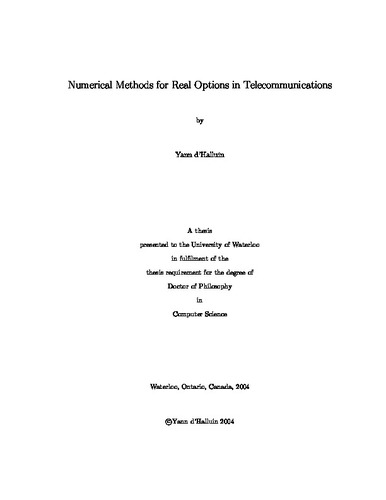UWSpace will be migrating to a new version of its software from July 29th to August 1st. UWSpace will be offline for all UW community members during this time.
Numerical Methods for Real Options in Telecommunications
| dc.contributor.author | d'Halluin, Yann | en |
| dc.date.accessioned | 2006-08-22 14:23:23 (GMT) | |
| dc.date.available | 2006-08-22 14:23:23 (GMT) | |
| dc.date.issued | 2004 | en |
| dc.date.submitted | 2004 | en |
| dc.identifier.uri | http://hdl.handle.net/10012/1206 | |
| dc.description.abstract | This thesis applies modern financial option valuation methods to the problem of telecommunication network capacity investment decision timing. In particular, given a cluster of base stations (wireless network with a certain traffic capacity per base station), the objective of this thesis is to determine when it is optimal to increase capacity to each of the base stations of the cluster. Based on several time series taken from the wireless and bandwidth industry, it is argued that capacity usage is the major uncertain component in telecommunications. It is found that price has low volatility when compared to capacity usage. A real options approach is then applied to derive a two dimensional partial integro-differential equation (PIDE) to value investments in telecommunication infrastructure when capacity usage is uncertain and has temporary sudden large variations. This real options PIDE presents several numerical challenges. First, the integral term must be solved accurately and quickly enough such that the general PIDE solution is reasonably accurate. To deal with the integral term, an implicit method is suggested. Proofs of timestepping stability and convergence of a fixed point iteration scheme are presented. The correlation integral is computed using a fast Fourier transform (FFT) method. Techniques are developed to avoid wrap-around effects. This method is tested on option pricing problems where the underlying asset follows a jump diffusion process. Second, the absence of diffusion in one direction of the two dimensional PIDE creates numerical challenges regarding accuracy and timestep selection. A semi-Lagrangian method is presented to alleviate these issues. At each timestep, a set of one dimensional PIDEs is solved and the solution of each PIDE is updated using semi-Lagrangian timestepping. Crank-Nicolson and second order backward differencing timestepping schemes are studied. Monotonicity and stability results are derived. This method is tested on continuously observed Asian options. Finally, a five factor algorithm that captures many of the constraints of the wireless network capacity investment decision timing problem is developed. The upgrade decision for different upgrade decision intervals (e. g. monthly, quarterly, etc. ) is studied, and the effect of a safety level (i. e. the maximum allowed capacity used in practice on a daily basis—which differs from the theoretical maximum) is investigated. | en |
| dc.format | application/pdf | en |
| dc.format.extent | 1899790 bytes | |
| dc.format.mimetype | application/pdf | |
| dc.language.iso | en | en |
| dc.publisher | University of Waterloo | en |
| dc.rights | Copyright: 2004, d'Halluin, Yann. All rights reserved. | en |
| dc.subject | Computer Science | en |
| dc.title | Numerical Methods for Real Options in Telecommunications | en |
| dc.type | Doctoral Thesis | en |
| dc.pending | false | en |
| uws-etd.degree.department | School of Computer Science | en |
| uws-etd.degree | Doctor of Philosophy | en |
| uws.typeOfResource | Text | en |
| uws.peerReviewStatus | Unreviewed | en |
| uws.scholarLevel | Graduate | en |

